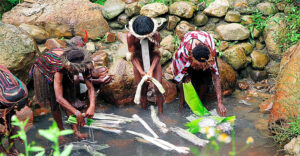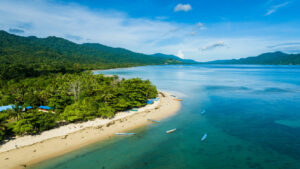
West Papua Province which has declared itself as a Conservation Province with a Special Regional Regulation (Perdasus) for Sustainable Development that is being designed cannot stand alone. It needs support from various parties, including the Central Government, Regional Governments, and Foreign Countries and Global Donor Institutions.
One crucial thing that needs attention is the incentive for conservation. Because, Indigenous people as the main actors of conservation need to pay attention to their welfare so they do not need to open or sell their forests as a solution to find income. This was specifically discussed at the second day of the 2018 International Biodiversity, Ecotourism and Creative Economy (ICBE) Conference in Manokwari, West Papua.
“If we think that conservation is a forest that cannot be cut down, then what do people eat? But if forests continue to be cut down so that there is income for the community, the forests and biodiversity contained therein will disappear and we only enjoy a moment, the natural conditions and biodiversity will not be enjoyed by our children and grandchildren 50-100 years in the future, we too it will be difficult to reforest, the forests that we have destroyed, “said the Secretary of the West Papua Province Drs. Nataniel D. Mandacan while speaking in one of the plenary sessions.
“Then we think about how the forest remains green, but the money still flows, so let’s think, here are lots of smart people, there is a central government and also national and international NGOs, let’s think about the mechanism, definitely meet,” explained Nataniel.
The challenge is how the central government and other environmentalists to jointly find an appropriate funding scheme so that Indigenous people working to protect forests and other conservation areas in Tanah Papua do not feel economically deprived. The Government of West Papua Province itself targets for 70% of its area to be used as a conservation area in the Spatial and Regional Design Plan (RTRW) which will be reviewed in line with regional regulations to be issued related to the RTRW Revision in West Papua Province.
Related to the seriousness of the Regional Government to expand the conservation area according to the percentage in the RTRW and protect biodiversity, it is hoped that the Central Government can support by issuing policies to secure the will of the region. Besides that, regarding the incentives for the Regions in the form of Ecological Fiscal Transfers that are being proposed, it is hoped that there will be no rules that actually hinder and instead like killing innovation. Whereas the purpose of establishing this conservation area is to help the Central Government’s desire to maintain carbon stocks to keep the pace of climate change. If people feel there is no appreciation and incentive for them to protect their forests or peatlands, then their forests may be sold and logged to meet their economic needs, “added Nataniel.
In a different plenary, researcher from the Research Center for Climate Change at the University of Indonesia Sonny Mumbunan said funding from the Central Government was possible to be carried out through the General Allocation Fund mechanism. The formula, the land cover indicator can be used as a reference in channeling the allocation of funds from the State Budget.
“So for regions that have a certain forest land cover and experience increased area cover, that can be given incentives. I have discussed this mechanism in the Ministry of Finance to the Ministry of the Interior and received different responses, “explained Sonny Mumbunan.
He called this mechanism already successful in Brazil and India. Therefore, this has a chance of success if you see the conditions of Indonesia and India are almost the same.
“Therefore, it all depends on the Central Government. The Regional Government only needs to push, like the West Papua Provincial Government which already has a commitment and Regional Regulation in the form of Perdasus which has been submitted to the West Papua Parliament to be discussed and determined, only the legal umbrella will be made by the Central Government, “said Sonny.
On different occasions, academics from the University of Papua Ludia Wambrauw requested that the funds that were included in the framework of conservation should not be given directly to the community without any assistance. The reason is, some examples of cases show that the use of funds is only temporary and fails.
“Funding is important, but the most important thing is assistance in order to remain sustainable. If you want the long term, there must be assistance to the community so that the economy that is built is also sustainable, “he said.
To that end, local governments can utilize development partners who have so far provided direct assistance to the community, both from NGOs and academics.
Ensuring that the community’s economy is sustainable is also voiced by Hans Mandacan as the actor and manager of ecotourism in the Arfak Mountains.
“Everything must be sustainable, therefore the forest must be maintained, because for us the forest and all its contents are atm and money machines that always print money for the community,” he said.
ICBE 2018 last day, Wednesday (10/10/2018) will discuss partnerships in realizing sustainable development and the process of policy and global partnerships before closing. According to the plan, there will be 3 parallel sessions and 2 plenary sessions before the closing.







